Bloat is one of the
common problems encountered with small ruminants. If treated properly and
aggressively, most cases have a favorable outcome. Many bloat conditions can be
prevented by using proper nutrition and sound management.
Clinical Signs:
- A distended abdomen, mostly on the left side, high in the flank area is
the most common sign. (If the animal is pregnant and seems to be distended
on both sides of the abdomen, special consideration should be given to a
possible hydrops animal. If this is a concern, consult a veterinarian.)
- The animal may have difficulty breathing, extend its neck, and even make
grunting sounds.
- Signs of colic may also be present (kicking at abdomen, getting up and
down, etc.).
Causative Agents: There are two major categories of bloat:
- Free-gas/Frothy bloat - This type of bloat can be brought on by
diets that cause excessive gas production in the rumen and decrease the
rumen pH. Diets high in grains, lush legumes, or winter wheat are causes of
this problem. This type of bloat can also be caused by poorly digestible
feed material and problems with indigestion.
- Problems that are outside of the rumen - These include choke and
position of the animal.
Diagnosis: Most of the time this problem is not difficult to diagnose.
Many animals suffering from bloat can be identified just by appearance. The
difficulty arises when the exact cause for the bloat must be determined. To help
determine the exact cause of the bloat, the following procedures should be
performed on each animal:
- Pass a stomach tube into the rumen. See page C854 for suggestions on
passing a tube. This will relieve any gas and potentially any fluid. If gas
and/or fluid feed material come out of the tube, assume the animal has some
type of gas or frothy bloat problem. At this point, any fluid from the
stomach can be tested for pH level. If the pH level is lower than
approximately 5.5, the bloat may be caused by grain
overload. For additional
information on pH testing, refer to page D630.
- If the tube does not pass easily, the animal could be choked and extreme
care should be used in passing the tube. If after a few gentle attempts, the
tube does not pass easily, consult a veterinarian.
- Listen to the rumen in the left flank area. This can identify if the bloat
is caused by indigestion. See "Diagnosis" portion of indigestion
on page F358 and refer to page C888 for information on listening to the
rumen.
Treatment:
- For simple gas and frothy bloat problems, passing a tube into the rumen to
relieve gas and fluid is essential. (Information on passing a tube can be
found on page C854.) Then liquid dishwashing detergent (10-20 mLs),
Therabloat (poloxalene) (5.5 mLs per 100 lbs. of body weight), dioctyl sodium
sulfosuccinate (DSS) (15-30 mLs), or another gas-reducing product should be
given by drench or stomach tube. If signs of breathing problems and severe distress are present
or routine treatment does not relieve the problem, it may be necessary to
insert a large gauge needle or trocar into the rumen in the left flank area.
Additional instruction may be required to perform this properly (see the
following pictures). If grain overload is suspected, see page F288.
- Probios or another source of gut flora should also be given.
- For problems causing bloat outside of the rumen, the underlying cause must
be determined and proper treatment begun. Diagnosing these problems may
require the help of a veterinarian.
BUY THIS MANUAL NOW and have access to this article and 100's of others
just like it!
* Before initiating any treatment, CONSULT A VETERINARIAN!
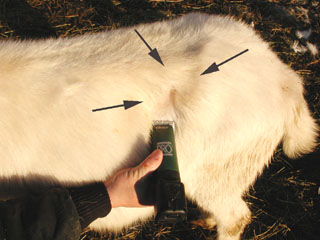 |
|
|
| The
arrows indicate the left flank region. The top arrow points to the
short ribs or transverse processes. The left arrow designates the
last rib and the right arrow points to the hip bone. |
|
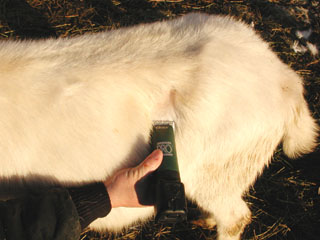 |
|
|
| This
area should be clipped, particularly over the spot with the largest
bulge associated with the rumen. |
|
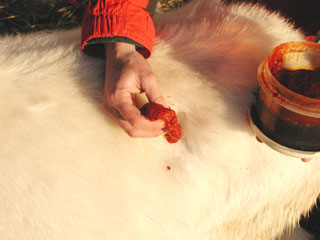 |
|
|
| Clean
the clipped area thoroughly with gauze 4 x 4s soaked in
betadine and alcohol. First, use one 4 x 4 soaked in
betadine. |
|
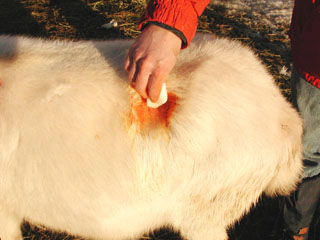 |
|
|
| Then
scrub the area with a gauze 4 x 4 soaked in alcohol.
Repeat this process of betadine and alcohol scrubs at least three
times using new 4 X 4s each time. |
|
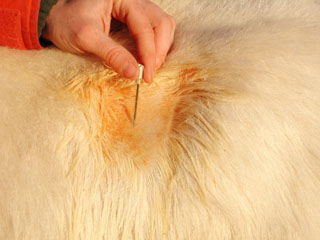 |
|
|
| Once
the area is sanitized, insert a 14 gauge, 2" needle in the
center of the clipped area where the largest bulge of the rumen can
be seen.
At this point, air can be let out, relieving much of the rumen
pressure. This procedure should be used in only the most severe
bloat cases. |
|
BUY THIS MANUAL NOW and have access to this article and 100's of others
just like it!
More Goat info,
More Sheep info
View some of the 10+
Video clips found in
the Small Ruminant Manual





